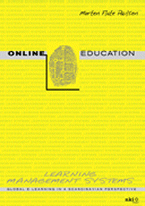Following up from my post earlier this week where I mentioned some advice given in a 2003 book by Professor Morten Flate Paulsen, comes some further pedagogical recommendations from Prof Paulsen. These are based on surveys he conducted in Scandinavian countries in the late 1990s and early 2000s - still relevant today I think:
- Have Clear Objectives
- Maintain as Much Flexibility as You Can
- Encourage Participation
- Maintain a Non-authoritarian Style
- Be Objective
- Don't Expect Too Much
- Don't Rely on Offline Materials
- Promote Private Conversations as well as those in the conference
- Find Unifying Threads
- Use Simple Assignments
- Make The Material Relevant
- Required Contributions
- Present Conflicting Opinions
- Invite Visiting Experts
- Don't Lecture
- Request Responses
Most educators will agree that the points above will probably apply in all educational settings, but I am drawn first to two (which are highlighted above).
Maintain a Non-authoritarian Style
Prof Paulsen suggests that it is "usually better to avoid the "authority figure" role when teaching online, especially with adults". There is no doubt about it, but already I feel as if I have total control in my new on-line classes - in Adobe Connect (the tool we use to deliver live classes) I am the "Host", while the students are "Participants". It's hard not to be "authoritarian" in such an environment. I have not yet grasped the system where control can be handed over to students - I need to get more comfortable and relaxed with Adobe Connect before I start giving control (authority) to students. Perhaps it shouldn't, but being a teacher in any learning environment does convey a certain natural authority - it's hard to overcome this in my experience.
Don't Lecture
My job title is "Lecturer in Computing". I am a Lecturer and it is hard to swallow a "Don't Lecture" recommendation. However, Prof Paulsen tells us that "Experience strongly suggests that a long, elaborate, logically coherent sequence of comments yields silence. Instead, use open-ended remarks, examples, and weaving to elicit comment and other views". I have certainly already adapted the "weaving" approach. My timetable says that I start with a two hour lecture, and follow this with a one hour tutorial. I never stick to this restriction, and I like weave in and out of short lecture/talk and practice. This is relatively easy to do in a module on Programming, where students are writing code almost all the time in my classes. For the first two weeks, I went through neither of the sets of lecture notes (PowerPoint slides) - I only dipped in and out when needed. I hope to keep this up. One of the best courses I ever attended was a CIPD Train-the-Trainer course. Our Lecturer/Trainer gave us a printed copy of her PowerPoint slides at the end of the 10 day course - we didn't even know they existed!


